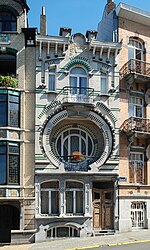Stade Joseph Marien
Belgian sports venue stubsFootball venues in BrusselsForest, BelgiumMulti-purpose stadiums in BelgiumOlympic football venues ... and 4 more
Royale Union Saint-GilloiseSports venues completed in 1919Summer Olympic venue stubsVenues of the 1920 Summer Olympics

Stade Joseph Marien is a multi-use stadium in Brussels, Belgium. It is currently used mostly for football matches and is the home ground of Royale Union Saint-Gilloise. The stadium holds 9,400 since 2018 and was opened in 1919. It is located within the Duden Park in the municipality of Forest, and its entrance is at one end of the Rue du Stade.
Excerpt from the Wikipedia article Stade Joseph Marien (License: CC BY-SA 3.0, Authors, Images).Stade Joseph Marien
Rue du Stade - Stadionstraat,
Geographical coordinates (GPS) Address External links Nearby Places Show on map
Geographical coordinates (GPS)
| Latitude | Longitude |
|---|---|
| N 50.817777777778 ° | E 4.3291666666667 ° |
Address
Stade Joseph Marien - Joseph Marienstadion
Rue du Stade - Stadionstraat
1190
Belgium
Open on Google Maps









